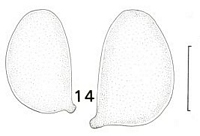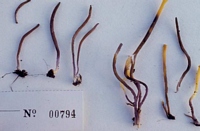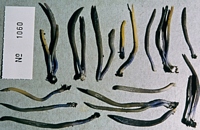|
 Clavaria flavopurpurea Clavaria flavopurpurea
BiostatusPresent in region - Indigenous. Endemic
Images (click to enlarge)
Caption: Fig. 14 Clavaria flavo-purpurea, spores, TENN no. 42942. | 
Caption: Microfiche 1-6. Clavaria flavo-purpurea. TENN no. 42492. | 
Caption: 1060, id. R. Petersen, label 50x10mm, NZ, NI, Waitakere R., Mill Bay, on soil among litter under
Leptospermum-Phyllocladus-Dacrydium, 06.07.1981, leg. EH
Owner: E. Horak |
Article: Petersen, R.H. (1988). The clavarioid fungi of New Zealand. New Zealand Department of Scientific and Industrial Research, Bulletin 236: 170 pp. Wellington:.
Description: Fruit bodies up to 7 cm high, up to 3 mm thick, simple clubs, narrowly fusiform, gregarious
to connate in small groups (up to 3 individuals), arising from small, tough, whitish mycelial
patches. Stipe base buffy grey ("tileul buff"), with a distinct ring above of grey-purple to
purple ("deep dull bluish violet 2", "deep violet plumbeus"), equal, not expanded at base.
Club "dark mouse-grey" to "dark olive-grey", equal or somewhat expanded upward, opaque;
apex narrowly rounded, purple, concolourous with ring on stipe; all parts slowly turning to
bright greenish yellow ("lemon-chrome") in old age and in 2% KOH solution.
Tramal hyphae of club up to 15 µm diam., hyaline, inflated, slightly thick-walled (wall up to
0.3) µm thick), free, parallel, clamped; secondary septa absent. Subhymenium poorly
developed. Hymenium thickening; basidia 80-100 x 7.5-8.5 µm, elongate-clavate, clamped;
contents multiguttulate at maturity, the guttules highly refringent; sterigmata 4, stout,
straight, divergent.
Spores 7.2-9.4 x 4.7-5.8 µm (E <= 1.43-1.63; Em =1.58; Lm = 8.25 µm),
ellipsoid to short-cylindrical, flattened adaxially, smooth, thin-walled; contents homogeneous to uniguttulate at
maturity; hilar appendix broad, papillate.
Habitat: On soil and humus.
Notes: This is a most handsome taxon. Purple colours are almost unknown in the subgenus, and the
slow change from purple to yellow is most striking especially on fruit bodies where all
colours are present.
The possession of elongate spores places the taxon with such others as Clavaria gracillima,
C. amoena (= C. aurantia), and C. fusispora. The complex has few taxa, and seems
pantropical in distribution, including eastern North America.
The nature of pigmentation in the group is not known, but probably includes carotenes. The
rapid colour change from purple to yellow in dilute KOH solution would indicate an
oxidation reaction, common in carotenes.
|